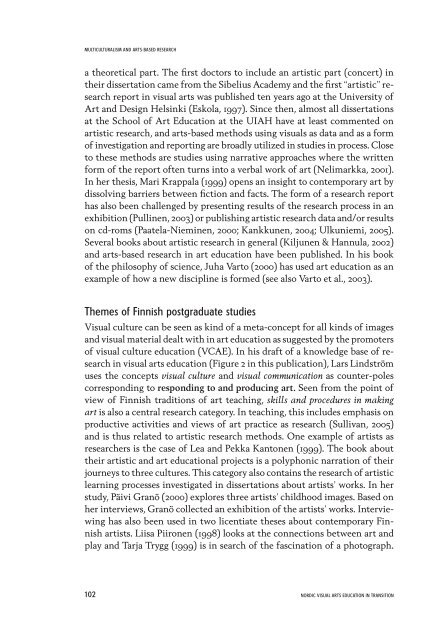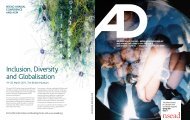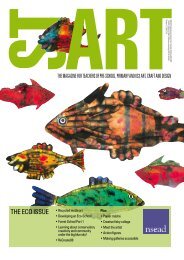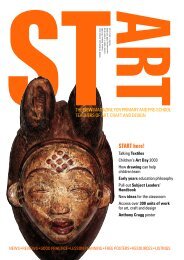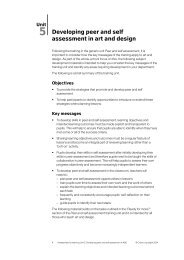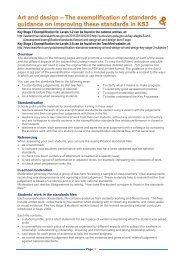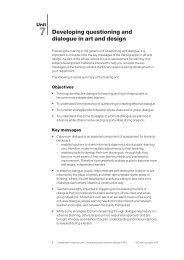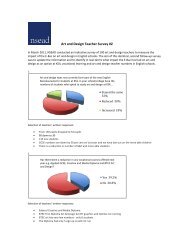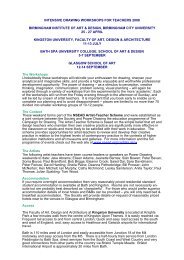Research in Visual Arts Education - Bilderlernen.at
Research in Visual Arts Education - Bilderlernen.at
Research in Visual Arts Education - Bilderlernen.at
Create successful ePaper yourself
Turn your PDF publications into a flip-book with our unique Google optimized e-Paper software.
MULTICULTURALISM AND ARTS-BASED RESEARCHa theoretical part. The first doctors to <strong>in</strong>clude an artistic part (concert) <strong>in</strong>their dissert<strong>at</strong>ion came from the Sibelius Academy and the first “artistic” researchreport <strong>in</strong> visual arts was published ten years ago <strong>at</strong> the University ofArt and Design Hels<strong>in</strong>ki (Eskola, 1997). S<strong>in</strong>ce then, almost all dissert<strong>at</strong>ions<strong>at</strong> the School of Art <strong>Educ<strong>at</strong>ion</strong> <strong>at</strong> the UIAH have <strong>at</strong> least commented onartistic research, and arts-based methods us<strong>in</strong>g visuals as d<strong>at</strong>a and as a formof <strong>in</strong>vestig<strong>at</strong>ion and report<strong>in</strong>g are broadly utilized <strong>in</strong> studies <strong>in</strong> process. Closeto these methods are studies us<strong>in</strong>g narr<strong>at</strong>ive approaches where the writtenform of the report often turns <strong>in</strong>to a verbal work of art (Nelimarkka, 2001).In her thesis, Mari Krappala (1999) opens an <strong>in</strong>sight to contemporary art bydissolv<strong>in</strong>g barriers between fiction and facts. The form of a research reporthas also been challenged by present<strong>in</strong>g results of the research process <strong>in</strong> anexhibition (Pull<strong>in</strong>en, 2003) or publish<strong>in</strong>g artistic research d<strong>at</strong>a and/or resultson cd-roms (Pa<strong>at</strong>ela-Niem<strong>in</strong>en, 2000; Kankkunen, 2004; Ulkuniemi, 2005).Several books about artistic research <strong>in</strong> general (Kiljunen & Hannula, 2002)and arts-based research <strong>in</strong> art educ<strong>at</strong>ion have been published. In his bookof the philosophy of science, Juha Varto (2000) has used art educ<strong>at</strong>ion as anexample of how a new discipl<strong>in</strong>e is formed (see also Varto et al., 2003).Themes of F<strong>in</strong>nish postgradu<strong>at</strong>e studies<strong>Visual</strong> culture can be seen as k<strong>in</strong>d of a meta-concept for all k<strong>in</strong>ds of imagesand visual m<strong>at</strong>erial dealt with <strong>in</strong> art educ<strong>at</strong>ion as suggested by the promotersof visual culture educ<strong>at</strong>ion (VCAE). In his draft of a knowledge base of research<strong>in</strong> visual arts educ<strong>at</strong>ion (Figure 2 <strong>in</strong> this public<strong>at</strong>ion), Lars L<strong>in</strong>dströmuses the concepts visual culture and visual communic<strong>at</strong>ion as counter-polescorrespond<strong>in</strong>g to respond<strong>in</strong>g to and produc<strong>in</strong>g art. Seen from the po<strong>in</strong>t ofview of F<strong>in</strong>nish traditions of art teach<strong>in</strong>g, skills and procedures <strong>in</strong> mak<strong>in</strong>gart is also a central research c<strong>at</strong>egory. In teach<strong>in</strong>g, this <strong>in</strong>cludes emphasis onproductive activities and views of art practice as research (Sullivan, 2005)and is thus rel<strong>at</strong>ed to artistic research methods. One example of artists asresearchers is the case of Lea and Pekka Kantonen (1999). The book abouttheir artistic and art educ<strong>at</strong>ional projects is a polyphonic narr<strong>at</strong>ion of theirjourneys to three cultures. This c<strong>at</strong>egory also conta<strong>in</strong>s the research of artisticlearn<strong>in</strong>g processes <strong>in</strong>vestig<strong>at</strong>ed <strong>in</strong> dissert<strong>at</strong>ions about artists’ works. In herstudy, Päivi Granö (2000) explores three artists’ childhood images. Based onher <strong>in</strong>terviews, Granö collected an exhibition of the artists’ works. Interview<strong>in</strong>ghas also been used <strong>in</strong> two licenti<strong>at</strong>e theses about contemporary F<strong>in</strong>nishartists. Liisa Piironen (1998) looks <strong>at</strong> the connections between art andplay and Tarja Trygg (1999) is <strong>in</strong> search of the fasc<strong>in</strong><strong>at</strong>ion of a photograph.102 NORDIC VISUAL ARTS EDUCATION IN TRANSITION


